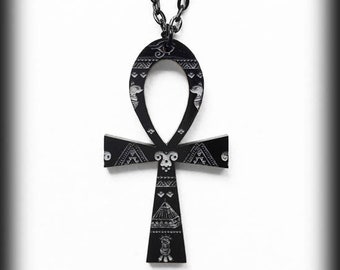

They usually have sharp edges, while traditional Christian crosses are rounded. Gothic crosses might be a bit different than the ones you see on church altars. Skeletons can be seen throughout Gothic history as a symbol of mortality and humanity’s connection to nature (because we are all made from the earth). The skull is a common motif in many forms of gothic art because it represents the transience and vanity of life on earth. Gothic jewelry often features skulls, which are symbols of death. They symbolize sadness because of their fragrance that is said to remind people of the smell at funerals. Gothic roses are usually black or dark red. Like bats, demons have often been associated with death and darkness. Many gothic pieces have demonic faces engraved on them to symbolize evil and darkness. Read more about the meaning of feathers in jewelry. The feathers themselves could stand for their souls or prayers ascending straight up to God. Feathers were a symbol of the apostles, who angels carried into Heaven after death. Feathersįeathers are another common element in Gothic jewelry. Many people in the Middle Ages believed that black bats could help them predict future events, such as death or bad luck. Gothic jewelry often features bats as their central theme. Common elements of gothic jewelry include: Bats Some of them have unique features that can increase their wearer’s charm and beauty. Gothic jewelry, such as neckties or collars with nails, earrings with screws, are mainly worn as accessories or jewelry. Gothic art often incorporated Christian symbolism- which is why so many dark objects have been dubbed “gothic.” The pointed arches symbolize spiritual growth (which you can compare with the rounded arch that represents God’s grace).įuneral Vampire Coffin Stainless Steel Gemstone Ring Features of Gothic jewelry The late medieval era lasted from the thirteenth to fifteenth centuries and was a time of extreme religious fervor.
SILVER ANKH VAMPIRE WITH RED WINGS 3D WINDOWS
These tall buildings had big open spaces inside, with stained glass windows that let beams of colored light into the dark churches and cathedrals. This type of arch is much stronger than a rounded one- which was necessary when building materials weren’t always reliable.

Gothic arches are known as ogives, and they usually have semicircular or pointed tops (known as “arrises”). Gothic architecture was typical in the middle ages. Gothic art has a very dark and dramatic feel- think of the pointed arches, spires that stretch to the sky with intricately carved faces at their apexes, and gothic cathedrals covered in complex patterns. The style is most commonly seen in architecture, furniture, and jewelry. This type of jewelry is often associated with death, darkness, mystery, and romance- so if you’re looking for something different than your typical delicate piece or diamond studs, gothic might be just what you need! It only fits then that this powerful form of art should have a mysterious name. The style was initially called “goth” because it was considered barbaric (and therefore uncivilized) by neighboring cultures at the time. Gothic history stretches to Ancient Rome.

Gothic jewelry is an elegant and dark form of jewelry that has been popular for centuries, with the first examples dating back to the 12th century.


 0 kommentar(er)
0 kommentar(er)
